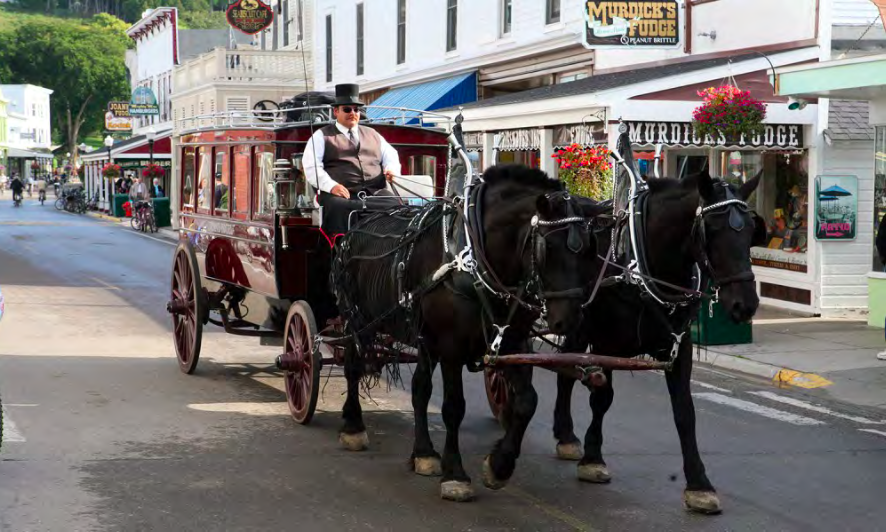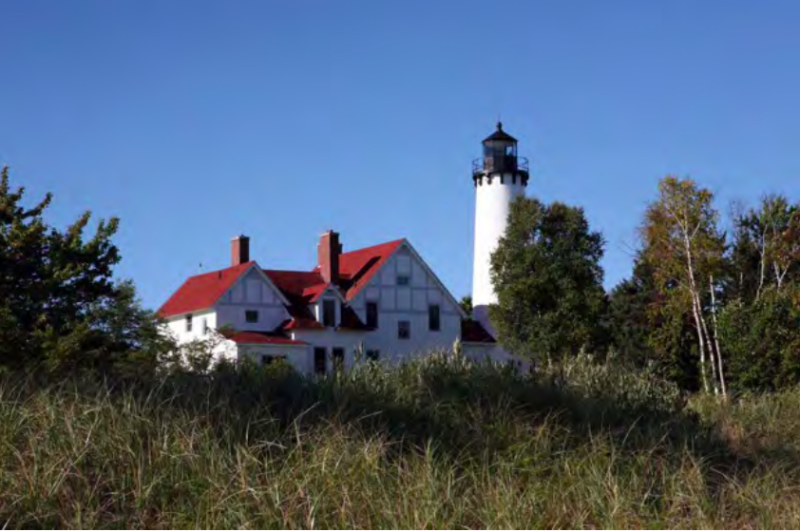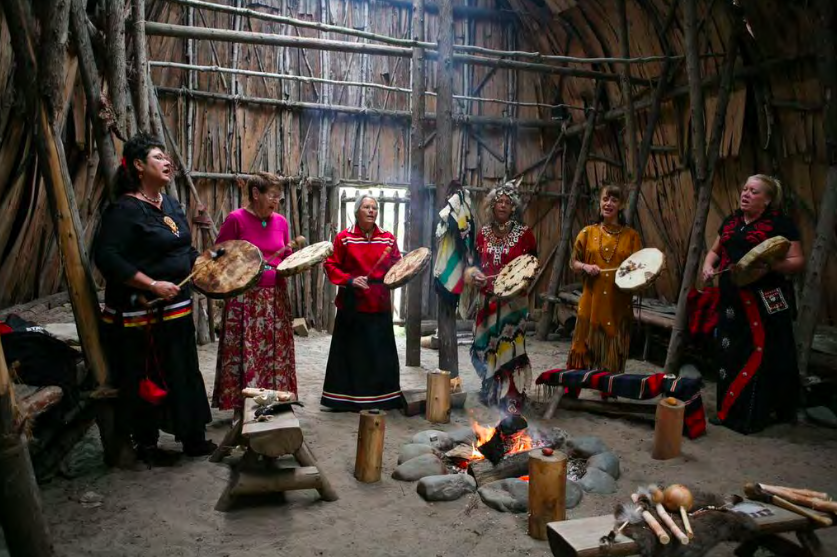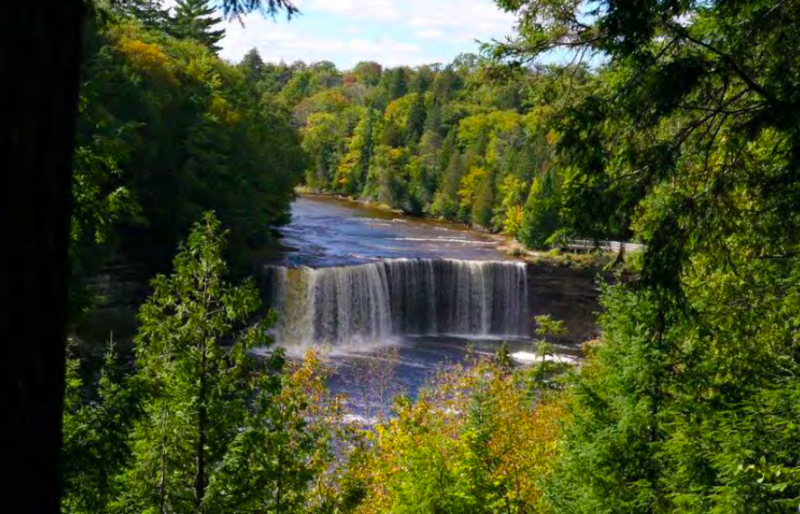
Many people travel to Michigan’s Upper Peninsula, otherwise known as the UP, just to visit Mackinac Island, but there’s a world of other adventures in the UP, including viewing lighthouses by land and sea, nautically themed scenic drives, breweries, boat tours and beyond.
The beautiful and historically treacherous waters of three of the Great Lakes and the St. Mary’s River surround Michigan’s Upper Peninsula.
The identity of the people and towns of the UP has been shaped by all of this water and the vast UP’s remote location. Traveling here, you’ll hear tales of lighthouse keepers and their families, fur traders, priests and devastating shipwrecks. The below is the itinerary that we roughly followed while filming in Michigan, including restaurants, hotels and activities. Perhaps our adventures will spur some trip ideas for your Upper Peninsula escape!

Day 1 St Ignace
The closest airport to St Ignace, our first stop, is Chippewa County International Airport (CIU), which is less than a 40 minute drive to St Ignace. One of the oldest continuous settlements in the United States, St. Ignace is a small town with a rich history.
Arrive and take a drive through town to the Huron Boardwalk, where there’s a St Ignace walking trail that goes right along the coastline. Walking along the Huron Boardwalk is an active way to take in history. All along the boardwalk, there are historic stops and if you have the time and energy, this trail can take you beyond St Ignace. The Huron Boardwalk runs along the North Country Trail, a National Scenic trail that stretches from New York to North Dakota.
Trail displays include a rudder from a 1212 ton wooden steamer sunk in the Straits in the spring of 1894. There’s a windlass from the wreckage of a ship, which sank off the coast in the 1890’s, and an original Mackinaw boat built in the St. Ignace area around 1899. Michigan has more lighthouses than any other state and you can spot one, the St. Ignace Lighthouse, along the trail. The Straits are the only place where the North Country Trail is on Lake Huron and when you are in that park, you can see Mackinac Bridge.
Stroll along Kiwanis Beach, the landing site where Father Marquette came to start a Jesuit Mission located right across the street. Father Marquette was a French priest and explorer, who lived in this area among Native Americans, the Ojibwa, also known as the Chippewa, from 1666 until his death in 1675.
Dinner
Eat by the water at the Mackinac Grille Restaurant & Waterfront Patio Bar (251 South State Street St. Ignace). Feast on seafood and local beer while you watch the boats coming and out of the harbor.
Stay
Balsams Cabins and Balsams Resort and Motel (1458 W US 2 St. Ignace) offers simple cabin accommodations and basic rooms. We suggest getting a cabin, where you can have your own campfire and truly feel like you’ve stolen away from it all. There’s a natural beach for taking in a UP sunset.
Day 2 St Ignace
Breakfast
Drive into town for breakfast at Bentley’s B-n-L Café (62 N State St, St Ignace, MI 49781), which feels like an old-fashioned American diner, complete with vintage bar stools and classic chequerboard floor tiles.
Morning
Head to Shepler’s Dock (601 North State Street in St. Ignace) for a lighthouse boat cruise. This is a good chance to see the marvel in architecture that is Mackinac Bridge, also known as Mighty Mac, which you’ll pass under shortly after your departure. Mackinac Bridge is one of the world’s longest suspension bridges and vital in connecting the Upper and Lower Peninsula in Michigan. Lighthouses are often in hard to reach places, which makes a boat tour a really great way to get up close. Some that we saw on our Eastbound Cruise included the Round Island Light, Bois Blanc Light, Poe Reef and Fourteen Foot Shoal Lights.
Lunch
Eat a pocket-sized, yet filling, pasty at The Taste of the UP (236 W. US-2 St. Ignace, MI 49781). Similar to an empanada or calzone, pasties are pastry shells normally filled with meat, traditionally roast beef, vegetables and potatoes and baked. It was typically found wherever you would find mining, and was brought over to the UP by Cornish immigrants in the 19th century. They carried their tradition of bringing pasties for their lunch in the tin mining region of Cornwall, England over to the iron mines of the Upper Peninsula, where it was also a great meal for miners, because pasties stay hot for a very long time and are filling. One will certainly fill you up in the UP! The choice is whether to eat your pasty with ketchup or gravy.
Afternoon
Visit to Museum of Ojibwa Culture and Father Marquette Mission Park (500 N State St, St Ignace, MI 49781) to delve further into the area’s past and current native culture. The museum and park focuses on life for the Ojibwa, Huron and French peoples who lived in the sometimes-harsh environment of the Great Lakes region in the 17th century, when hunting, fishing and nature’s bounty sustained life and culture for the Ojibwa, also known as the Chippewa. The museum holds a number of events, including drumming workshops, and is a good place to shop for unique craft items.

If you have time, next visit the Fort De Buade Museum (334 N State St, St Ignace, MI 49781) and head to Bridge View Park (Boulevard Dr. St. Ignace, MI 49781) for some of the best views of Mackinac Bridge. Castle Rock (N2690 Castle Rock Road St. Ignace on I-75 going North), which is shrouded in local myths and interesting geological significance, is a good place to take a panoramic photo of the area, including Mackinac Island on a nice day.
Night again in St. Ignace at Balsams Cabins & Resort.
Day 3 Sault Ste Marie
Drive about one hour to Sault Ste Marie. Located near the border with Ontario, Sault Ste Marie rests along the St. Mary’s River, a major highway for massive ships. One of the best known attractions in Sault Ste Marie are the Soo Locks, built in 1855 to enable ships to travel between Lake Superior and the lower Great Lakes. Ships are lifted up or down to compensate for a 21-foot difference in the water level between Lake Superior and the lower Great Lakes. Because of the high traffic at these locks, travelers can usually spot a freighter passing through and see how these locks actually work firsthand.
Just down the road, you can tour a lake freighter, the SS Valley Camp (501 East Water Street, Sault Ste. Marie, MI 49783). Built in 1917, this over 11,000-ton freighter shipped everything from iron ore and coal to grains and stone throughout the Great Lakes. See firsthand how the crew lived and ran this massive ship. If you have time, take the elevator up in the nearby Tower of History to see 210 feet above the Soo Locks and the city of Sault Ste Marie.
This evening, take a Soo Locks boat tour at sunset, getting the chance to actually travel through the Locks and take in pretty views.
Dinner
If you like kitsch, stop by The Antlers Restaurant (804 East Portage Ave. Sault Ste. Marie, MI 49783) across from the Soo Locks for dinner, where taxidermy is on display and portions are plentiful.
Day 4 Scenic Drive
Today is devoted to a scenic drive, including to lighthouses, museums and landmarks. Here’s the route we recommend.
Drive from Sault Ste Marie to the Mission Hill Cemetery and scenic overlook. If the weather is nice, this is a photogenic stop with views of Lake Superior, the Saint Mary’s River, Spectacle Lake and the western shore of Canada. The cemetery is a resting place for sailors who’ve perished on the Great Lakes, including sailors from the SS Myron. Their grave is well marked. The SS Myron was caught in a November gale in the early 1900s during one of Lake Superior’s bad storms.
Next stop at Point Iroquois Lighthouse (12942 West Lakeshore Drive, Brimley, MI), which is situated on a beautiful rocky beach above Whitefish Bay. The interesting history, walkable shoreline and the fact that you can actually climb up to the top of this lighthouse, make it a worthwhile visit. In the 1950’s a light keeper and his family lived at Point Iroquois. An exhibit inside the museum takes you back in time to the families who spent holidays and childhoods here, personalizing the site for travelers.
Enjoy a nature walk and lunch at Tahquamenon Falls State Park (41382 W M-123, Paradise, MI 49768), which has 40 miles of hiking trails and the second largest waterfall east of the Mississippi. It’s also home to a pub and microbrewery started by Lark Ludlow, whose grandfather owned the land surrounding the falls and sold it to the state to make sure it would be preserved for generations to come. Stop by for a seasonal brew and lunch. Blueberry beer was on tap during our visit.

Enjoy the dramatic shore at The Whitefish Point Light Station (18335 N Whitefish Point Rd, Paradise, MI 49768), which has one of the most beautiful and bone chilling beaches I’ve ever visited. This lighthouse has served as a much needed beacon since 1849, making it the oldest active light on Lake Superior. Inside the Great Lakes Shipwreck Museum, you can see maritime artifacts, including the bell from the famed Edmund Fitzgerald, which sank in Lake Superior off Whitefish Point in 1975. The entire crew was lost and it’s one of the greatest mysteries of the Great Lakes, because no one knows what really happened.
Day 5 Mackinac Island
Take the ferry from St Ignace to Mackinac Island. We used Shepler’s Ferry from St. Ignace. Make a plan to stay at either one of the island’s many B&Bs or the upscale and historic Grand Hotel.
Mackinac Island is a dream destination for many travelers, especially those keen on history and architecture. Automobiles were banned on Mackinac Island more than 100 years ago, because they scared the horses. While on the island, travelers must get around like the locals, on horseback, via horse drawn carriage or taxi, by bicycle or on foot.
Explore the island on horseback with Cindy’s Riding Stable (7447 Market St, Mackinac Island, MI 49757) or drive a carriage through Jack’s Livery Stable, right down the road.
Next explore The Grand Hotel, perhaps for lunch or to enjoy some time in a rocking chair on the porch. The 1980 sci-fi romance “Somewhere in Time,” starring Christopher Reeve and Jane Seymour was filmed on Mackinac Island and features The Grand Hotel, an iconic resort that’s a must see on the island. Clinton, Bush, Ford, Kennedy, and Truman are just some of the prominent guests who have visited this family-owned historic hotel.
The Grand Hotel is a large wood frame hotel, one of last remaining from the 19th century. Located on a bluff overlooking the water, this historic summer destination has been attracting guests for over 125 years. One of the main draws–– its gigantic porch over 600 feet long.
Make a plan to visit the Grand Hotel Carriage Museum, where you can learn about the history of horse drawn transportation on the island. Almost everything still today on Mackinac Island is moved around via horse power, including garbage pick ups and UPS!
Day 6 Mackinac Island
Explore more of Mackinac Island State Park and the island today. Over 80 percent of Mackinac Island is state park, and there are over 60 miles of trails within the park, so whether you’re hiking, biking or riding horses, you can spend time in nature. Make sure to stop by Arch Rock, a curious limestone formation on the Lake Huron shoreline in Mackinac Island State Park. One of the best places to take views and spot a lighthouse is from the highest point on the island at Fort Holmes.
Fort Mackinac, which was founded during the American Revolution, is another must-see and accessible from Main Street, where fudge shops abound. Another fun and free thing to do is to enjoy the architecture of the beautiful cottages that like so many aspects of Mackinac Island, bring the past to life.
Whatever you do, make it a point to enjoy the beautiful natural areas that are so prevalent along Michigan’s Upper Peninsula and enjoy!



